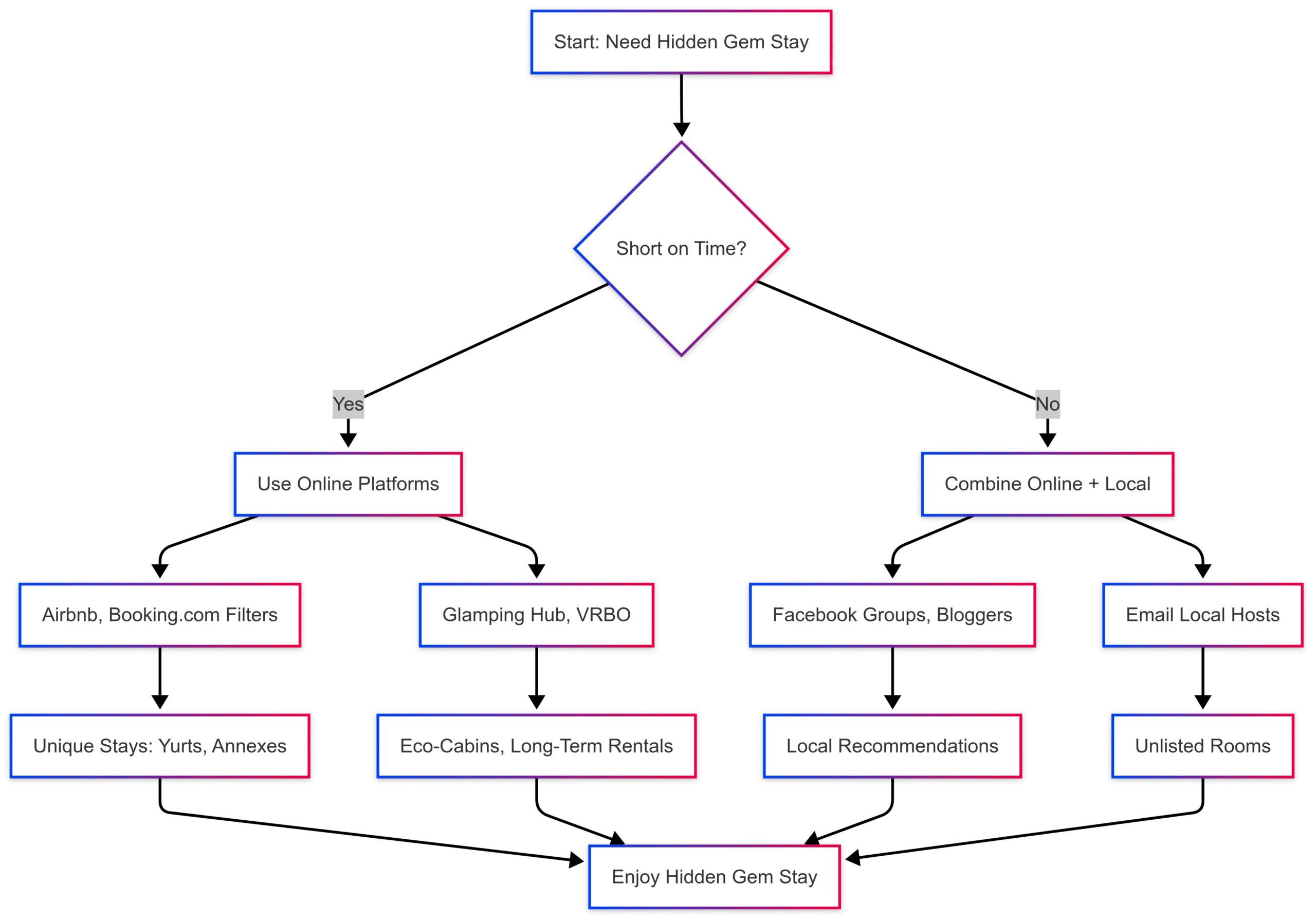Discover hidden gem accommodations for your Canary Islands holiday with expert tips on finding unique, local stays.
Travelers seeking authentic experiences often crave accommodations that break away from cookie-cutter hotels and corporate chains. These “hidden gem” stays—whether a yurt in the Canary Islands, a fisherman’s cottage in Bali, or a converted barn in Ireland—offer unforgettable memories and a deeper connection to the destination. For your upcoming holiday in the Canary Islands, where surfing and hiking define your days, this guide provides actionable strategies to uncover unique, locally beneficial accommodations that align with your rebellious travel spirit. With only a week to plan, we’ll focus on efficient methods to find non-tacky, budget-friendly stays that prioritize experience over luxury.
Why Hidden Gems Matter for Rebellious Travelers
Rebellious travelers, like yourself, prioritize experiences over conventional comforts. A plush hotel with a generic view might satisfy some, but you’re after the charm of a small apartment benefiting a local family or an annex tucked away from tourist traps. These stays aren’t just about sleeping—they’re about immersing yourself in the culture, meeting locals, and creating stories worth sharing. In the Canary Islands, where tourism dominates, finding these gems requires strategy, especially with limited planning time after your six-month Asia backpacking adventure.
Step-by-Step Guide to Finding Hidden Gem Accommodations
1. Leverage Online Platforms with Precision
Online booking platforms are your first stop, but generic searches yield touristy results. Use filters and niche websites to uncover unique stays.
- Airbnb: Use filters like “Unique Stays” or “Superhost” to find quirky options like tiny homes, eco-lodges, or fisherman’s cottages. For the Canary Islands, search for terms like “traditional Canarian house” or “rural finca.” Expect nightly rates from €40-€100 for one-bedroom apartments or annexes.
- Booking.com: Select “Apartment,” “Guesthouse,” or “Homestay” under property type. Sort by “Guest Review Score” to prioritize authentic stays. Prices for guesthouses in Tenerife or Gran Canaria range from €35-€80.
- Niche Platforms:
- Glamping Hub: Ideal for yurts, treehouses, or eco-cabins. Glamping in the Canary Islands starts at €60/night.
- VRBO: Best for longer stays (weekly rentals). Look for “Vacation Rental by Owner” listings in quieter islands like La Gomera, starting at €300/week.
- AllTheRooms: Aggregates listings from multiple platforms, including lesser-known sites, to uncover hidden options.
Tip: Read reviews carefully, focusing on mentions of local hosts, unique features, or proximity to hiking trails and surf spots. Avoid listings with overly polished photos that scream corporate management.
2. Tap into Local Knowledge
Locals know the best spots, especially in tourism-heavy destinations like the Canary Islands. With only a week to plan, online communities and quick outreach are key.
- Social Media Groups: Join Facebook groups like “Canary Islands Expats” or “Tenerife Travel Community.” Post a specific request, e.g., “Looking for a budget-friendly, local apartment in La Gomera for surfing and hiking.” Expect responses within hours.
- Local Bloggers: Search for Canary Islands travel blogs on Google or Instagram using hashtags like #CanaryIslandsLocals or #TenerifeOffTheGrid. Bloggers often highlight family-run guesthouses or secluded rentals. For example, blogs like “Tenerife Insider” recommend stays in villages like Masca.
- Direct Contact: Email or call small guesthouses or rentals directly. If a listing on Booking.com says “fully booked,” contact the host—cancellations are common, and locals may have unlisted rooms. This persistence often secures unique stays like a €50/night room in a restored Canarian farmhouse.
Table 1: Platforms for Local Recommendations
| Platform | Type | Best For | Approx. Cost (Night) |
|---|---|---|---|
| Facebook Groups | Social Media | Quick local tips | Free to join |
| Instagram Bloggers | Social Media | Visual inspiration, niche stays | Free to follow |
| Wikivoyage | Travel Wiki | Overview of lesser-known areas | Free |
| Local Tourism Boards | Website/Email | Authentic guesthouses | €40-€100 |
3. Explore Alternative Accommodation Types
For a rebellious traveler, standard hotels are a last resort. The Canary Islands offer diverse options that blend adventure and authenticity.
- Glamping: Stay in a yurt or eco-cabin near Anaga Rural Park (Tenerife) for €60-€120/night. These sites offer proximity to hiking trails and starry skies, perfect for your outdoor-focused trip.
- Homestays: Platforms like Homestay.com connect you with local families. A private room in a Gran Canaria family home costs €30-€50/night and often includes breakfast or local insights.
- Hostels with Private Rooms: Hostels like La Tortuga (Gran Canaria) offer private rooms for €25-€40/night. They’re social, budget-friendly, and often locally owned, ideal for meeting fellow surfers or hikers.
- Work Exchanges: Use Worldpackers to trade a few hours of work (e.g., helping at a surf camp) for free accommodation. A week-long stay might cost €15-€30 in fees, with meals included.
- Traditional Stays: Look for “casas rurales” (rural houses) on platforms like EscapadaRural.com. These restored homes in villages like El Hierro start at €50/night and support local economies.
Chart: Accommodation Decision Flow

4. Embrace the Rebellious Travel Philosophy
Your Asia backpacking experience proves you’re comfortable with spontaneity. Apply that mindset to the Canary Islands, even with a tighter timeline.
- Stay Flexible: Book refundable options for the first night or two, then adjust based on local tips. For example, start in Puerto de la Cruz (Tenerife) and move to a rural stay in La Gomera if recommended.
- Prioritize Experience: Choose a €40/night fisherman’s annex over a €150/night resort. The annex might lack Wi-Fi but offer a surfboard rental or a host who points you to secret trails.
- Avoid Tourist Traps: Skip areas like Costa Adeje (Tenerife) or Playa del Inglés (Gran Canaria), where corporate hotels dominate. Focus on quieter islands like La Palma or El Hierro for authentic vibes.
Tip: Use Google Maps to zoom into rural areas like Valle Gran Rey (La Gomera). Look for small guesthouses or apartments not listed on major platforms. Contact owners directly for deals.
Recommended Hidden Gems in the Canary Islands
Based on your surfing and hiking plans, here are curated stays across the Canary Islands. Prices are approximate and vary by season.
Table 2: Hidden Gem Accommodations
| Location | Accommodation | Type | Features | Price/Night | Booking Platform |
|---|---|---|---|---|---|
| Anaga, Tenerife | Finca El Picacho | Rural House | Hiking trails, ocean views | €65 | EscapadaRural |
| El Médano, Tenerife | La Tortuga Hostel | Hostel | Private rooms, surf lessons | €35 | Booking.com |
| Valle Gran Rey, La Gomera | Casa Rural Los Helechos | Rural House | Near surf beaches, local host | €50 | VRBO |
| Tijarafe, La Palma | Eco Yurt La Palma | Glamping | Stargazing, hiking access | €80 | Glamping Hub |
| El Pinar, El Hierro | Casa Abuela | Homestay | Family-run, breakfast included | €40 | Homestay.com |
Highlights:
- Finca El Picacho: A restored farmhouse in Anaga Rural Park, ideal for hiking. The host offers trail maps and local wine.
- Eco Yurt La Palma: A sustainable yurt with solar power, perfect for surfers and stargazers. Located near Punta Gorda beach.
- Casa Abuela: A cozy homestay in El Hierro, where the host’s family shares stories and homemade meals.
Tips for Maximizing Your Search
- Google Smart: Search terms like “Canary Islands unique stays,” “Tenerife local apartments,” or “La Gomera casas rurales.” Add “blog” or “forum” to find personal recommendations.
- Check Wikivoyage: The Tenerife and La Gomera pages list lesser-known villages like Taganana or Hermigua, where local stays thrive.
- Trust Your Gut: If a listing feels too commercial, skip it. Look for personal touches in descriptions, like “my grandmother’s house” or “handmade furniture.”
- Negotiate: For stays longer than three nights, message hosts for discounts. A €60/night apartment might drop to €50/night.
Challenges and How to Overcome Them
- Limited Availability: Popular hidden gems book fast. Use multiple platforms and contact hosts directly to snag cancellations.
- Language Barriers: Some local hosts speak only Spanish. Use Google Translate for emails or ask about English-speaking contacts.
- Touristy Overlap: Even “hidden” areas can feel crowded in peak season. Stick to smaller islands like La Palma or El Hierro for quieter stays.
- Time Constraints: With only a week, prioritize two or three platforms (e.g., Airbnb, Booking.com, Glamping Hub) and one social media group.
Why These Stays Enhance Your Canary Islands Adventure
Your holiday focuses on surfing and hiking, and hidden gem accommodations amplify these experiences. A rural house near El Médano (Tenerife) puts you steps from world-class surf breaks, while a yurt in La Palma offers trailheads at your doorstep. These stays also support local economies, aligning with your preference for benefiting communities over corporations. Unlike a resort, where you’re just a guest, these accommodations make you part of the island’s story.
Conclusion
Finding hidden gem places to stay in the Canary Islands is about blending technology, local insights, and a rebellious mindset. Use Airbnb and Booking.com for quick wins, tap into Facebook groups and bloggers for insider tips, and embrace alternative stays like glamping or homestays. With these strategies, your week-long holiday will be filled with authentic experiences, from surfing in El Médano to hiking in Anaga. Book that quirky annex, chat with your host, and let the islands’ magic unfold.
Please share this How do you find the ‘hidden gem’ places to stay? with your friends and do a comment below about your feedback.
We will meet you on next article.
Until you can read, 9 Strategies for Learning About Local Customs and Traditions
